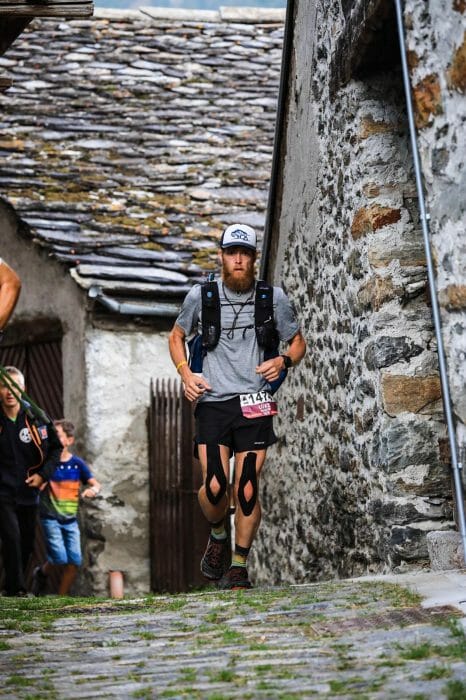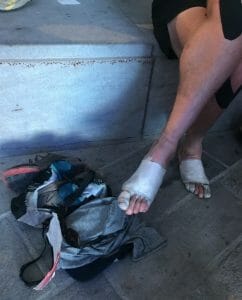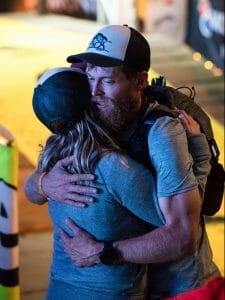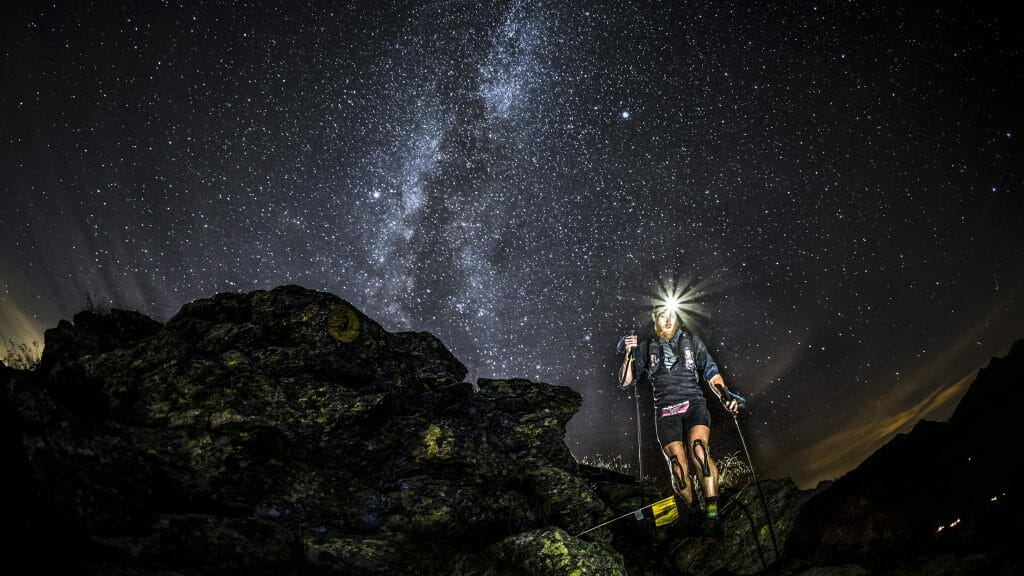The hallucinations had gotten more frequent. So frequent that anytime I allowed my eyes to drift away from the small cone of light provided by my headlamp I saw something that didn’t belong. A moose appeared behind a rock. Various sea creatures, octopus and squid the most frequent, wrapped around trees and roots. From what I can recall, the vast majority of them were related to the interface of light and shadow.
Then there was a frog.
This frog was different than the others: it was in the middle of the trail. My headlamp lit the area, somewhere around 9,000 feet above sea level in the middle of the night. It was cold, too cold for a frog. At least that is what I thought. Out of the fog of sleep deprivation came the idea to take a photo with my phone. Then I could prove to myself it was just another hallucination and carry on. I pulled out the phone, took the picture, and stared at the screen in a stupor of disbelief. It was there! Somehow, this unnerved me more than the fictitious shapes in the dark. Muttering to myself, something about needing to get a little sleep at the next life base, a place I wouldn’t arrive at for another 4 or 5 hours, I stepped over the frog and started running.
Nine months prior to seeing the frog in the middle of the trail, I told my coach, Scott Johnston, that I wanted to explore the edges of my potential as an endurance athlete. In a career spanning more than a decade I had gotten too comfortable with the races and events I was doing. When I stood at the starting line of a 100-mile race, there was no longer doubt about my ability to finish. Only questions about how quickly. I told Scott that I wanted to try the Tor des Geants® in 2018, a mountain race in the Italian Alps that is 219 miles (350 kilometers) in length with 89,000 feet of ascent. It is notoriously difficult, very long, and I was unsure if I could finish it. Scott agreed to help me prepare.

With the rising of the sun, the hallucinations faded into the daylight. I arrived at the next aid station and was very disappointed to learn it was not where I would see my partner and number one supporter, Tanae. Seventeen years ago, when we married, I wasn’t a runner. Running joined our relationship just prior to us having our oldest daughter, and Tanae gracefully allowed it to be part of us as she constantly supported and believed in what I was doing. Tanae was in Italy with me, like so many other times before, to help me push past preconceived limitations. I tried to sleep at the aid station, but it was noisy and busy. I needed the mental boost that seeing Tanae would provide. The sleep I so desperately wanted eluded me, and after a few minutes I got up and marched out.
A climb and descent of around 4,000 feet stood between me and the next life base. My sleep-deprived mind had allowed me to leave the aid station without filling my bottles, and the climb was in full morning sun. Quickly the sweltering heat brought a strong thirst, and with empty bottles things started to feel a bit desperate.
To add to the desperation of the situation, I had suddenly been caught and passed by eight or nine runners, all moving fast and looking quite fresh. I hadn’t seen that many other runners since the first day and couldn’t figure out how I had fallen back so quickly. Near the top of the climb was a small plexiglass cube, large enough for two cots and a couple benches. It had been flown in by helicopter as a remote aid station. I filled my bottles and in the heat of the clear box passed out for a 10-minute nap.
When I woke the volunteers explained that I had not lost any positions but had been caught by the leaders of the shorter Tot Dret, the 130-kilometer little brother of the Tor des Geants®. Refreshed from the good news, the nap, and some lukewarm soda water, I set back out on the trail, looking forward to running down to the life base.

Scott and I were not starting from scratch as we set out to prepare for the Tor. I had the base of many years of endurance training, yet the demands of day-to-day life would not make the preparation any easier. I have a full-time job as a physician assistant, three kids, and the responsibilities of being a professional athlete. Training would have to be concise. Every workout would have to count.
Scott did a wonderful job of guiding me through several phases of training over the months leading up to the race. A large phase of volume-building to start, all at an easy pace to build aerobic capacity. The next phase was muscular endurance. This included an incredible sequence of progressive workouts that challenged both my body and mind. The hard workouts were really hard and the easy workouts were actually easy (hard to do when time is so precious). As the muscular endurance workout progression continued, over a period of more than 16 weeks, I felt improvements with each workout.
The final phase, a combination of volume and muscular endurance, pulled my fitness to levels that I had not previously seen. One test piece, a local hill lovingly referred to as Stupid Steep, was the location of a lot of the hardest work. The hill climbs 1,500 vertical feet in 0.68 mile. During full-length repeats, three at a time, my averages dropped more than 5 minutes per ascent over the period.
During this several-month buildup, I experienced a substantial increase in stress and workload at my job. Occasionally workouts were missed or modified to accommodate my work life. Scott kept a close eye on my preparation and my responses to it, constantly adjusting the workload to just the right amount to not break me, but to maximize training time and efficiency. When it was time to taper, travel to Italy, and toe the line, I felt fitter than ever before. Oddly, the uncertainty of being able to finish this very difficult challenge had faded. What once had felt beyond me now felt well within reach.
I was surprised at Saint Rhémy, the last crew-accessible aid station, to see Tanae there waiting for me along with a few friends. This wasn’t planned, but it was such a lift to my battered body and brain. I looked terrible, but was moving well. The pain in my feet that had developed early on along the long, unrelenting descents was nearly gone; I’d drained the blood blisters under my toenails and had received an expert tape job a full day prior.
Tanae vibrated with excitement as I got up to leave the aid station. She offered simple encouragement—“See you at the finish!”—followed by a peck on the cheek. I joked with my dear friend Roch as I started up the hill behind the aid station. Tears of joy ran down my cheeks for several miles. It occurred to me that this whole endurance running thing really takes more than just me, and that I have the best support on the planet.
Hours later, in and out of a very dense fog, I could barely see my feet. Lightning flashing above offered glimpses of the peaks surrounding me and also led to an overwhelming sense of isolation. I could see nothing beyond the cone of my headlamp and the occasional flash of peaks above.
As I crested the Col of Malatra, I badly wanted to be done. An odd pain in my right foot had developed just below my ankle where my shoe seemed to be rubbing. A short descent after the col delivered me to another plexiglass cube aid station. Two volunteers who looked like paramedics seemed to emerge out of an otherworldly portal, yet they happily greeted my arrival. I promptly asked them for a pair of trauma shears as I peeled off my shoe. To their surprise I took the shears and hastily hacked off the offending part of the shoe, then handed back the scissors. They appeared shocked I would make such a dramatic change to my footwear so far from anywhere, but the shock quickly shifted to amusement at my odd decision. A pair of high-fives followed and I was off into the dark and fog. Over the last 8 to 10 miles I experienced an incredible surge of energy. I was able to run—not an ultra death-shuffle, but run. It was surreal to have such a strong surge after so long on the trail.
When I stood at the starting line of the Tor, I had some of the typical prerace nerves. I knew it would be very hard, but I knew I had done the work. My body and mind were ready. I managed to cover the 200-plus miles in 85 hours and 21 minutes, good enough for eighth place. While the sleep deprivation brought on by only 2.5 hours of sleep made for some very strange hallucinations, I did not have any particularly low patches, and I was surprised at how well my body held together through the demanding descents and arduous ascents.
The training had been very precise, with relatively low mileage that, for the nine months leading up to the Tor, averaged only 43 miles a week. Despite this low mileage, the amount of ascent was high and all the workouts were high quality. While the hallucinations were the making of my mind alone, I owe Scott an incredible amount of credit for the way my body felt throughout. I am also forever grateful to Tanae for the unwavering support along this journey. One of the biggest things I learned from the Tor is that confronting the impossible can be made possible with the appropriate amount of support, preparation, and guidance.
-by Uphill Athlete Luke Nelson Title photo: Luke Nelson near the Rifugio Coda on day 2 of the Tor des Geants. Stefano Jeantet Photo.

